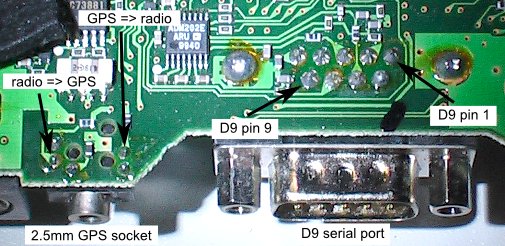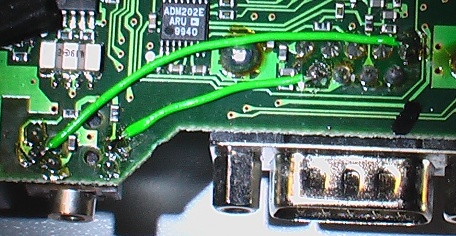Kenwood TM-D700 gps mod.en
All the usual disclaimers apply to the information below. This information is based on an early model Kenwood TM-D700E and might not apply to all/later versions of the radio. If you break your radio, you get to keep all the pieces.
GPS connector rerouting for Kenwood TM-D700
The GPS-connector (2.5mm stereo plug/socket) in the Kenwood TM-D700 is somewhat unreliable, especially if the radio part and cables aren't properly mounted somewhere out of reach. One way to fix this is to reroute GPS communications to the D9 serial port connector. This modification adds two short jumper wires (Kenwood-green!) to the circuit board, no external modifications to the radio are necessary.
Opening the radio
If you have a mobile mounting bracket fixed to the radio, you might want to remove it first. To get to the circuit board the connectors are mounted onto, you need to remove both top and bottom covers of the radio (11 screws). The speaker will probably be loose once the top cover is removed, so you might want to unplug and remove it before continuing. You might also want to clean the fluff, dust and whatnot from the heat sink, now that you have the radio open. The plastic front cover is is held in place by fragile black plastic tabs that are visible once you remove the top and bottom covers. Removing the front cover and turning the radio upside down exposes the circuit board the connectors attach to.
Connector pinouts
Originally there are four unused pins (1, 4, 6, and 9) in the D9 connector on the TM-D700. Two of those are needed for bidirectional GPS communications, ground is already wired to D9 pin 5. The GPS socket has five pins, of which three are in use.
The picture below shows one way of rerouting the GPS data. Here the serial port D9 pin 1 is connected in parallel to the tip of the 2.5mm GPS socket (NMEA waypoints from radio to GPS). The D9 pin 9 is in parallel to the ring of the GPS socket and carries NMEA data from the GPS to the radio. This also leaves the 2.5mm GPS socket functional, in case you want to use it.
Thus the pinout for a GPS cable is as follows on a female D9 connector:
- pin 1: NMEA from radio to GPS
- pin 5: ground
- pin 9: NMEA from GPS to radio
Afterthoughts
Pin 1 on the D9 connector is designated in the RS-232 specification as DCD (data carrier detect) and 9 is RI (ring indicator). Having these wired to the GPS/NMEA socket shouldn't cause problems if you connect the radio to a computer via the serial port, but your mileage may vary. If you want to be sure or use both a GPS and a computer simultaneously, you can make a splitter cable that separates the GPS/NMEA signals from the computer serial port.
As two pins of the D9 are still unused, you could in some cases also power your GPS via the D9 connector. If you try to do that, make sure you know what you are doing.

